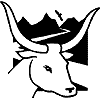Facts & Figures The Burren
The Burren is located along Ireland’s mid-Western coast, stretching across approximately 72,000 ha of north Clare and south Galway. The region extends from sea level to heights of just over 300m.
Read more on:
Geology
The Burren is composed of layers of limestone, deposited during the Lower Carboniferous period, underlain by Galway granite and was originally capped by a layer of Namurian shale. The shale cover was stripped away by successive glaciations surviving only on ‘nunatacks’ in places such as Slieve Elva (344 m) in the south west of the region.
There are two distinct regions; the ‘high Burren’ where terraced hills reach a maximum altitude of approximately 330 m and the ‘low Burren’, a flat limestone plain with an average altitude of 20-30 m.
Climate
The climate of the Burren is mild with mean daily temperatures greater than 14°C in July and August (the warmest months) and less than 5°C in January and February (the coolest months).
The average annual rainfall is high, c.1525 mm, with October to January being the wettest period when rainfall is approximately 160 mm per month (Irish Meteorological Service 2008).
Flora
The Burren is best known for its flora. Three quarters of Ireland’s 900 native plant species are found here, including specialities such as the dense-flowered orchid (Neotinea maculata), spring gentian (Gentiana verna) and mountain avens (Dryas octopetala).
The unique assemblage of plant species is of exceptional value and includes arctic, alpine and Mediterranean plants, as well as calcareous and acid loving species, all of which may be found growing together. Alpine species occur at sea level. Many of these species grow in a profusion unrivalled elsewhere in Britain and Ireland.
Fauna
The diversity of habitats in the Burren is reflected in the range of its fauna. The flower- rich grasslands, scrub and woodlands are important for butterflies, moths and pollinators such as bees. The Burren is home to Ireland’s only native reptile, the viviparous lizard (Lacerta vivipara). One hundred and two bird species have been recorded breeding in the Burren which represents approximately 70% of Ireland’s breeding bird species.
Mammal species include the Irish hare (Lepus timidus hibernicus), badger (Meles meles), otter (Lutra lutra), pine marten (Martes martes), stoat (Mustela erminea), red squirrel (Sciurus vulgaris), wood mouse (Apodemus sylvaticus), pygmy shrew (Sorex minutus), bank vole (Clethrionomys glareolus), feral goat (Capra hircus) and eight of Ireland’s 10 native bat species, including the rare lesser horseshoe bat (Rhinolophus hipposideros).
Priority Habitats
The nature conservation value of the Burren is recognised by the designation of approximately 30,400 ha as SAC (Special Area of Conservation) under the EU Habitats Directive.
Priority and other EU habitats found in the Burren that are listed on Annex I of the EU Habitats Directive include limestone pavement, orchid-rich dry calcareous grassland, limestone heaths, turloughs, petrifying springs, hard nutrient-poor lakes, calcareous fens and blanket bog.
Cultural Heritage
The Burren has been inhabited for thousands of years and, as such, the cultural wealth of the Burren is highly significant.
Archaeological remains are common throughout the landscape. The layer upon layer of archaeological features, extending back almost 6,000 years to the famous Poulnabrone dolmen (one of over 80 megalithic tombs in the region), are testament to the millennia of unbroken human settlement and to the easy availability of durable limestone for building.
Demographics
The Burren is predominately a rural landscape with the majority of towns and villages situated along the peripheral northern and western seaboards and along the southern border.
In recent years the economy of the Burren has shifted away from agriculture and its associated industries towards the service sector, namely tourism. In 2002, agriculture accounted for 9% of the labour force in County Clare (within which most of the Burren lies) but it had decreased to 6% by 2006. Between 1991 and 2000, the number of smaller farms (<30ha) decreased significantly. The viability of farming and the impact that this may have on the Burren communities and their agricultural practices is of great concern, particularly as it may have an irreversible impact on the heritage values of the region.

This graph shows the declining number of males employed in agriculture in the Ballyvaughan RD (which covers most of the west Burren). (Both * and** refer to number of males and females employed) (source: CSO assorted dates)



















